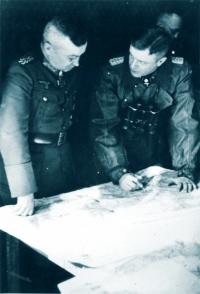
Heinz Harmel (right), commander of SS Frundsberg Panzer Division, with Field Marshal Walter Model, commander Army Group B, at Arnhem.
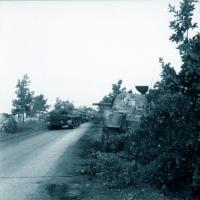
Sherman tanks of the Irish Guards Group advance past others which were knocked out earlier during Operation Market-Garden.
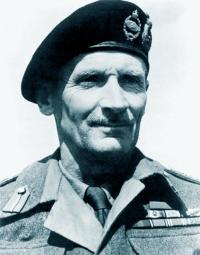
Field Marshal Bernard Montgomery
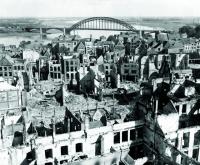
Nijmegen, with bridge in background, after the battle, 28 September 1944.
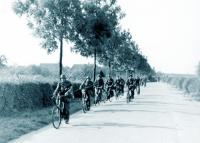
SS Troops advancing on bicycles.
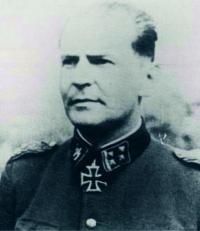
Walter Harzer, Commander SS Hohenstaufen Panzer Division at Arnhem, wearing Knights Cross, which he earned at Arnhem.
Seventy years ago on Sunday September 17, 1944, 500 gliders and 1,500 air transports flew from their bases in England destined for Holland. This air armada carried elements of the First Allied Airborne Army to land it behind German lines, along a highway in Holland, that stretched for more than 60 miles. This airborne army was to occupy a corridor leading to the town of Arnhem across the lower Rhine river. The goal of this gigantic air drop was to establish a bridgehead across the Rhine river which would enable the British Second Army to cross it and move into the northern plain of Germany to facilitate the destruction of German Army Group B. Like all the other military operations before it, the purpose of this one was to end the war in Europe quickly and send the boys home by Christmas.
After the Allied breakout from Normandy, in August 1944, their forces moved very rapidly across France and into Belgium. Attacking on a broad front, the Allied armies shattered German resistance and moved almost unchecked to the German border. The speed of the Allied advance began to place significant strains on their increasingly long supply lines. To address this problem, the "Red Ball Express" was created to rush supplies to the front. Using nearly 6,000 trucks, the “Red Ball Express” operated until the opening of the port of Antwerp in Belgium in November 1944.
Forced by the supply situation, General Dwight D. Eisenhower, the Supreme Allied Commander, began to contemplate the Allies' next move. General Omar Bradley, commander of the 12th Army Group in the Allied center, advocated a drive into the Saar to pierce the German Westwall (Siegfried Line) defenses and open Germany to invasion. This was countered by Field Marshal Bernard Montgomery, commanding the 21st Army Group, in the north, who wished to attack over the lower Rhine into the industrial Ruhr Valley. As the German's were using bases in Belgium and Holland to launch V-1 buzz bombs and V-2 rockets at Britain, Eisenhower sided with Montgomery. If successful, Montgomery would also be in a position to clear the Scheldt islands, which would open the port of Antwerp to Allied vessels.
To accomplish this, Field Marshal Montgomery developed Operation Market-Garden. A two phase operation, the plan called for troops from Lieutenant-General Lewis Brereton's First Allied Airborne Army to land and capture key bridges in Holland. While these troops held the bridges, Lieutenant-General Brian Horrocks, commander of the XXX Corps, would advance up Highway 69 to relieve Brereton's men. If successful, Allied forces would be over the Rhine in a position to attack the Ruhr Valley, the industrial heart land of Germany, while avoiding the Westwall by working around its northern end.
Montgomery’s plan required precise coordination between the airborne and the ground elements. “Market” was the code name for the airborne element which called for about 35,000 troops to be dropped behind German lines to capture major roadway bridges in the Dutch cities of Eindhoven, Nijmegen, and Arnhem. The airborne forces would hold these key bridges until British XXX Corps, which was moving overland, code-named “Garden,” from the Belgian-Dutch border, would link up with the isolated airborne forces and advance across each strategically captured bridge. XXX Corps' timetable to travel the sixty-four miles to Arnhem Bridge was two to three days at the most. Upon Market-Garden’s success, the Allies would have outflanked the fixed German fortifications of the Siegfried line and have established a bridgehead across the Rhine. This was not to be the case. Unknown to the Allied planners, was the presence of the II SS Panzerkorps, which included the crack 9th and 10th SS Panzer Divisions. The divisions were resting and refitting in the areas north and south of Arnhem.
On September 17, 1944, the airborne element conducted the largest daylight drop in history. The pre-airborne drop bombardment, by B-17s of the Eighth Air Force, was very effective in reducing German anti-aircraft defenses. The heavy flak that was so instrumental in breaking up the formations of the C-47 troop carriers in the Normandy drop, and thereby causing the paratroopers to be scattered in the wind, wasn’t present in Holland.
For Market, the airborne component of the operation, Major-General Maxwell Taylor's 101st Airborne Division was to be dropped near Eindhoven with orders to take the bridges at Son and Veghel. To the northeast, Brigadier-General James Gavin's 82nd Airborne Division would land at Nijmegen to take the bridges at Grave. Further north, the British 1st Airborne Division, commanded by Major-General Roy Urquhart, and Brigadier-General Stanislaw Sosabowski's Polish 1st Independent Parachute Brigade, were to land at Oosterbeek and capture the bridge at Arnhem. Due to a lack of aircraft, the delivery of the airborne forces was divided over two days. Sixty percent arrived on the first day and the remainder, including most of the glider-born infantry, arrived on the second.
On 18 September, the second day, XXX Corps, composed of the Guards Armored Division, 43rd, and 50th Infantry Divisions, began to make the progress expected of them. Their tanks, moving up on a very narrow road, covered 20 miles in a few hours, hooking up with the Americans at one of the intact bridges near Grave. On the third day, they reached Nijmegen, where the Americans were still fighting in the streets in their efforts to reach the bridge across the Waal River. As aircraft flew over, the Allied guns began a huge barrage to hit the Germans guarding the road ahead.
Due to stiff German resistance and the slow advance of British XXX Corps, Allied troops were forced to abandon their positions near the bridge, and to try and fight their way out. Three miles from Arnhem, British paratroops were holding a pocket of land at the village of Oosterbeeck. By now XXX Corps was on the other side of the river from the airborne troops. However, they could not cross.
German artillery controlled the river and Horrocks decided to evacuate the British survivors. Only some 2,000 troops eventually made the crossing. The parachute division had left behind nearly 1,500 dead, and more than 6,500 prisoners, many badly wounded. Eighty percent of the British 1st Airborne Division would become casualties. The division never saw action again for the rest of the war.
Operation Market-Garden had failed. It would be another four months before the Allies crossed the Rhine again and captured the German industrial heartland of the Ruhr. The war dragged on, costing the lives of thousands of civilians and servicemen.
Operation Market-Garden was a complete failure. After the Germans stopped the Allied offensive at Arnhem, the Allies retreated back to Nijmegen to establish a defensive position. The highly specialized shock troops of the American 82nd and 101st Airborne Divisions remained under British operational control until November 1944. They were misspent as conventional infantry in stagnant defensive positions. Arnhem remained in German hands until the war’s end. Allied forces would not set foot on the northern bank of the Rhine again until April 1945.
Arnhem proved to be a bridge too far. In 1977 Richard Attenborough directed the epic movie "A Bridge Too Far" which dramatized the struggle of the British 1st Airborne Division in Arnhem against the German II SS Panzerkorps. Arnhem would be finally, and officially, liberated on April 14, 1945, by Canadian troops.
NEXT WEEK: RIGA





